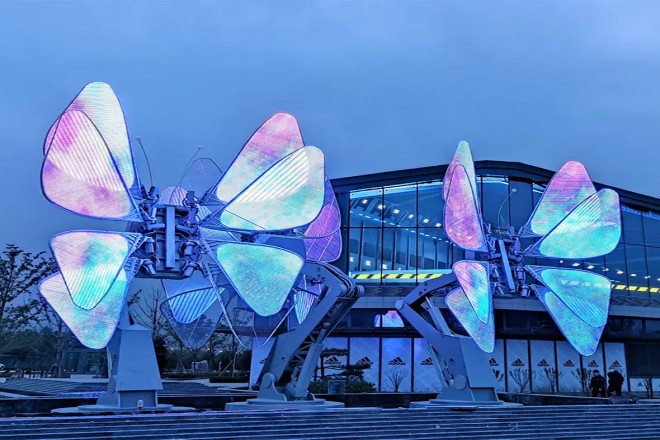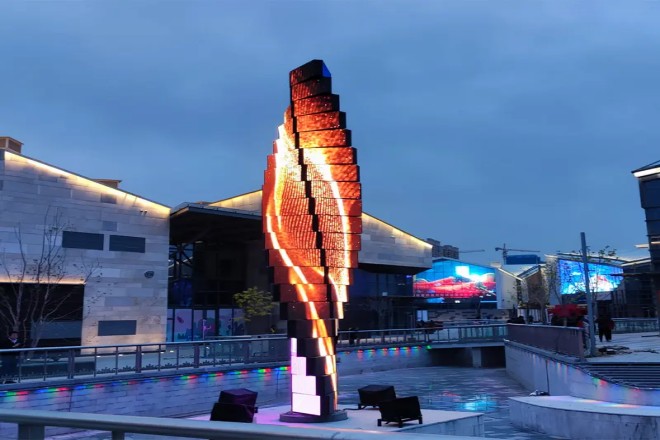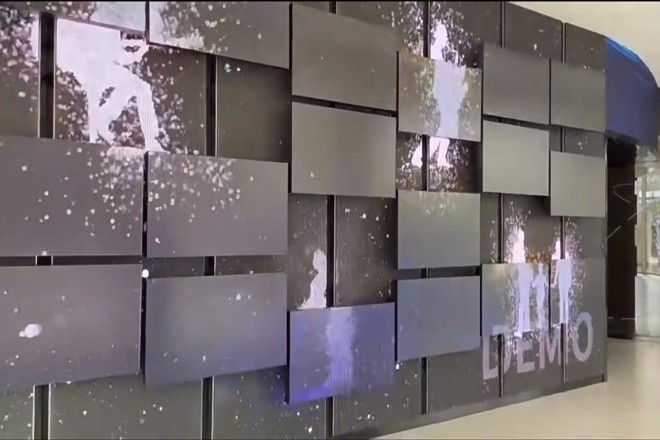소개

Have you ever seen a moving LED 디스플레이? Yes, this is a dynamic mechanical LED display. This type of display is a very advanced one in the current LED display market, and it is also the most attractive to the audience. So what should you pay attention to if you want to buy and install a dynamic mechanical LED display?
1. Consider whether your venue supports the installation of a dynamic mechanical LED display
When you plan to install a dynamic mechanical LED display in a venue, this is not just a simple installation process but a “big battle” that requires careful consideration of many factors. Below, let’s talk in detail about the key points you need to pay attention to:
1). Venue and space planning:
- Accurate measurement:
First, you have to take out a ruler and measure every inch of the installation area clearly. Don’t forget that the dynamic mechanical LED display is different from the ordinary LED display. In addition to the space required for installation and placement, it also requires additional space when exercising, so you have to reserve a place for it to “stretch its limbs.”
- Audience perspective:
Imagine where the audience is most comfortable standing. The height and angle of the screen must be taken into account to ensure that everyone can enjoy the best visual experience.
- Surrounding environment:
If it is installed outdoors, check if there are any obstacles around, such as trees, buildings, etc. Don’t let them block the audience’s sight, and don’t let the screen appear too abrupt.
2). Structural load-bearing and stability:
- Load-bearing assessment:
The weight of the dynamic mechanical LED screen is heavier than that of the ordinary LED display. In addition to its own weight, it may also have a certain impact when it moves. You have to ensure that the installation structure (whether it is a wall or a bracket) can withstand this force.
- Reinforcement measures:
If the original structure is not stable enough, it must be reinforced. It may be necessary to add steel bars, install expansion screws, etc., in short, to ensure that there is no risk.
- 안정성 테스트:
Before installation, it is best to do a stability test to simulate various situations when the dynamic mechanical LED screen moves to ensure that it will not shake.
3). Power supply and control system:
- 전원:
The dynamic mechanical LED screen is a big energy consumer. It takes electricity to light up the display and drive it. So you have to ensure that the venue can provide stable and sufficient power. It is best to have a backup power supply or UPS, just in case.
- Control system selection:
The control system is the “brain” of the screen. You have to choose a reliable and easy-to-operate one. It is best to choose one that can be remotely controlled, timed on and off, and customized with animations.
- Line layout:
The power lines and control lines should be arranged neatly, and don’t let them become safety hazards or affect the appearance.
4). Environmental adaptability:
- Indoor and outdoor differences:
Indoor installation should consider dust and dust prevention; outdoor installation should consider waterproof, sun protection, and corrosion resistance. You have to choose the right screen and protective measures according to the site environment. It should be noted here that not only the display itself, but also its mechanical parts should be dust and waterproof, such as: the grooves that slide up and down, etc.
2. Consider the needs and selection of dynamic mechanical LED display screens

1). What kind of dynamic effect do you need?
- The dynamic effect should be dazzling:
What kind of dynamic effect do you want? Is it undulating like waves, rotating like a fan, or flipping like a Rubik’s Cube? First, determine the dynamic effect you want so that you can find the corresponding dynamic mechanical LED display screen.
- The installation environment should be considered:
Where will the display screen be placed? Indoors or outdoors? Is the space big? Is the load-bearing capacity enough? These must be considered clearly; after all, the dynamic mechanical LED display is heavier than ordinary displays, and it has to move!
- The display content must be clear:
What do you want to show? Is it a high-definition video, or a beautiful picture? Or dynamic text? Choose the appropriate pixel pitch and resolution according to the content to ensure that the picture is clear and not blurry.
- The budget must be controlled:
To be honest, the dynamic mechanical LED display is not cheap. You have to have a budget first, and then find the most cost-effective product within this range. Don’t forget to consider the later operation and maintenance costs!
3. Is there a team that can install the dynamic mechanical LED display to help with the installation?
1). Can an ordinary LED display installation team do it?
This depends on the specific installation of the dynamic mechanical LED display. An ordinary LED display installation team may have basic LED display installation skills, but the dynamic mechanical LED display usually has a more complex structure and higher installation requirements.
If the ordinary team does not have relevant experience and professional skills, it may not be able to ensure the correct installation and good operation of the dynamic mechanical LED display. Therefore, when choosing an installation team, it is recommended to give priority to a professional team with experience in installing dynamic mechanical LED displays to ensure the quality and effect of the installation.
2). Is there a team in your local area that specializes in installing dynamic mechanical LED displays?
This is very important. The installation of dynamic mechanical LED displays is very delicate and professional, so you must make sure that you can find a professional installation team before buying. Otherwise, if you can’t install it after buying it, it will be very troublesome.
You can use search engines to search whether there is a professional dynamic mechanical LED display installation team in your local area or country. These teams usually have rich experience and professional skills to ensure the correct, safe, and efficient installation of dynamic mechanical LED displays.
They are familiar with the special structure and installation requirements of dynamic mechanical LED displays and can handle various complex situations to ensure the quality of installation.
4. Is the energy supply for dynamic mechanical LED displays sufficient?

1). Energy consumption characteristics of dynamic mechanical LED displays
Dynamic mechanical LED displays, due to their unique mechanical dynamic effects (such as lifting, rotating, flipping, etc.), require much more energy consumption than static or ordinary dynamic LED displays. This is mainly reflected in the following aspects:
- Mechanical drive energy consumption:
The movement of the mechanical structure consumes a lot of electrical energy, especially when the mechanical structure is complex, and the movement is frequent. Just like your hands are always moving, it will also consume energy.
- LED lamp energy consumption:
Although the energy consumption of LED lamp beads themselves is relatively low, dynamic mechanical LED displays usually pursue high brightness and high contrast, so the energy consumption of LED lamp beads cannot be ignored.
- Control system energy consumption:
In order to accurately control the coordinated work of the mechanical structure and LED lamp beads, the control system needs to run continuously, which will also consume a certain amount of electrical energy. Just like the human brain is always thinking and issuing instructions, it will consume a lot of energy.
2). Assessment of the adequacy of energy supply
- Electric power infrastructure assessment:
Before installing the dynamic mechanical LED display, a comprehensive assessment of the power infrastructure at the installation site is required. Ensure that the power supply is stable and sufficient to meet the energy consumption requirements of the display under maximum load.
If the installation location does not meet the energy supply requirements of the dynamic mechanical LED display, then even if it is installed, there will be no good effect.
- Energy management strategy:
An intelligent energy management system is used to monitor and adjust the energy consumption of the dynamic mechanical LED display in real time.
By adjusting the brightness of the display screen, the movement frequency of the mechanical structure, and other parameters, energy consumption can be optimized. It’s like installing a smart housekeeper to control and manage the dynamic mechanical LED display screen.
- Backup power supply plan:
For key places or important events, a backup power supply plan should be formulated. For example, a generator or energy storage device should be equipped to ensure that the normal operation of the display screen can be quickly restored in the event of a power outage.
This is very important. In case of a special event, electricity cannot be used, or there is a power outage, then the backup power supply can “rescue” you in time.
결론
Through the guide in this article, I hope you can have a more comprehensive understanding of the preparations before purchase, ensure that the display screen can operate safely and efficiently, and add infinite brilliance to your venue. May the mechanical LED display screen become a bridge of communication between you and the audience, and witness every wonderful moment together.
마지막으로 LED 디스플레이 화면에 대해 더 알고 싶다면, 우리에게 연락해주세요.
